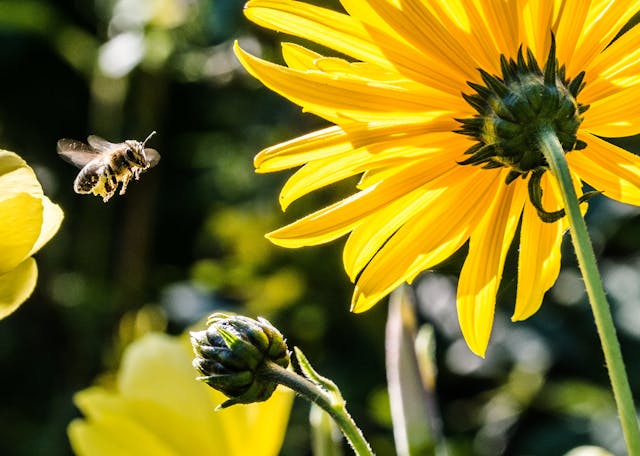
Why do bees buzz? Bees buzz because of the speed with which they beat their wings. All insects with wings make a sound, but some of them are too high pitched for us to be able to hear it.
Sound is made by something vibrating and passing that vibration on to the molecules near to it. The strength of the vibration determines how far the sound will travel. If you have a speaker, for example, it translates the electrical signal coming from your computer into movement. The drum inside the speaker moves a certain amount for each sound that it is receiving from the computer. That movement pushes the air molecules next to it, passing the energy on. Those molecules move and hit molecules next to them, and the sound wave moves on. The speaker will move very quickly, but it moves faster for high pitched sounds and slower for low pitched sounds. The fastest vibration that we can hear is 20,000 vibrations a second, which is 20,000 Hertz (20 kHz). This will be a very high-pitched sound for us. The slowest vibrations we can hear are 20 vibrations a second. This is 20 Hertz and it would be a very low-pitched sound to us. These are the limits of human hearing, but they vary with age. Other animals have different hearing ranges. An elephant can hear 17 vibrations a second and a ferret sixteen. On the other end of the scale, a bat can hear sounds at 200 kHz, which is 200,000 vibrations a second.
So, why do bees buzz? Because they are pushing the air around them. Imagine you have a towel and you flap it. The towel will push the air molecules out of the way and you will probably hear a crack or a whump. You wouldn’t be able to keep it up, but imagine you could flap that towel many times a second. This is what bees are doing. 20,000 species of bee have been identified so far and they range from tiny to fairly large. The largest bee is the leafcutter bee and it can be 4 cm long. Larger bees need to have larger wings and they need to flap them faster to stay airborne. The largest bees flap their wings about 200 times a second. That produces a sound of 200 Hertz, which we can hear as a relatively low-pitched buzz. Flies produce a higher pitched sound because they move their wings much more quickly. There are some midges that beat their wings at 1,000 times a second and that produces a much more high-pitched sound. Then, on the opposite end of the spectrum, most birds only flap their wings once or twice a second, which we cannot hear because it is too slow.
Insects have to flap their wings much faster than birds because they are so small. To fly, you need lift and thrust to overcome your weight and your drag, Large birds get a lot of lift from each flap of their wing and they can angle the wings to turn that into thrust. Insects are very small and they don’t get much lift from each flap. To overcome that, they need to flap a lot more. You can see the same thing with birds. Larger birds flap less than smaller birds. To be able to flap so rapidly, insects flap their wings in a different way to birds. Birds use muscles in the same way that we move our arms. Each flap is the result of a direct signal from the brain. Bees and many other insects can’t do that because the brain wouldn’t be able to send 1,000 signals a second. Try it. See how fast you can flap your hand. To get around this, the wings are usually attached to muscles that relax and contract automatically. The brain sends a signal to start flapping and the muscle to pull the wings down contracts. While it is doing this, the muscle to pull then back up again relaxes. The second muscle is activated by being stretched and when the wings are at the top, the first muscle relaxes and the second one contracts. As the first muscle gets stretched, it activates again, automatically. And this carries on. The brain only needs to send commands to turn or hover.
The way bees fly is actually quite interesting. If they just flapped their wings up and down, they wouldn’t be able to get enough lift to sustain flight and to be able to hover. To stay in their air, they flap their wings in a figure of 8 pattern. Each time they flap their wings they create a vortex on the trailing edge, which gives them lift. By turning their wings, they can move the vortex and change the position of the lift. This allows then to turn sharply and to hover. This vortex also allows then to have smaller wings that they would otherwise need. And this is what I learned today.
Sources
https://hypertextbook.com/facts/2000/NancyLee.shtml
https://wonderopolis.org/wonder/why-do-bees-buzz
https://en.wikipedia.org/wiki/Hearing_range
https://en.wikipedia.org/wiki/Bee
https://medium.com/@jonny.w.page/how-do-insects-beat-their-wings-so-quickly-4c7ebeba6872
Photo by Pixabay: https://www.pexels.com/photo/yellow-petaled-flower-with-black-yellow-bee-during-daytime-focus-photography-63641/
